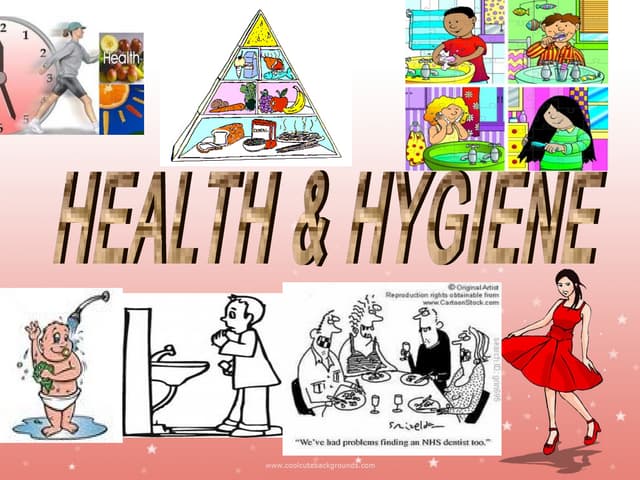Health and hygiene are integral aspects of our daily lives, profoundly influencing our overall well-being and quality of life. These two interconnected concepts encompass practices and behaviors that promote physical, mental, and social well-being. Maintaining good health and hygiene is not only crucial for personal well-being but also plays a significant role in preventing the spread of diseases and fostering a healthy society. In this article, we will explore the importance of health and hygiene, their impact on individual and community health, and practical steps to adopt healthier habits.
1: The Importance of Health and Hygiene
1.1 Definition and Scope
Health refers to the state of complete physical, mental, and social well-being, and not merely the absence of disease or infirmity. Hygiene, on the other hand, encompasses practices and behaviors that promote cleanliness and prevent the spread of illness and infection. Together, health and hygiene form a symbiotic relationship, where good health can only be achieved and maintained through proper hygiene practices.
1.2 Impact on Individual Health
A commitment to maintaining good health and hygiene is vital for individuals of all ages. Regular exercise, a balanced diet, adequate sleep, and personal hygiene practices contribute to physical fitness and well-being. Good hygiene practices, such as handwashing, can prevent the transmission of pathogens and reduce the risk of infections.
Additionally, mental health plays a crucial role in overall well-being. Engaging in stress-reducing activities, seeking social support, and practicing mindfulness can significantly impact mental health. Adequate sleep and maintaining a healthy routine also contribute to mental well-being.
1.3 Impact on Community Health
The health and hygiene of individuals extend beyond their personal well-being and significantly influence the health of their communities. Inadequate hygiene practices can lead to the spread of infectious diseases, putting the entire community at risk. Conversely, a community that prioritizes health and hygiene can experience reduced disease burden and better overall well-being.
2: Hygiene and Disease Prevention
2.1 The Role of Handwashing
One of the simplest yet most effective hygiene practices is handwashing. Regular handwashing with soap and water for at least 20 seconds can prevent the spread of various infections, including the common cold, flu, and gastrointestinal illnesses. Proper handwashing should be done after using the restroom, before eating, and after coughing or sneezing.
2.2 Personal and Dental Hygiene
Practicing personal hygiene involves maintaining cleanliness of the body and clothing. Regular bathing, brushing teeth, and wearing clean clothes are essential aspects of personal hygiene. Good dental hygiene, such as regular brushing, flossing, and dental check-ups, helps prevent oral health issues like cavities and gum disease.
2.3 Food Safety and Hygiene
Proper food safety and hygiene are crucial in preventing foodborne illnesses. This involves storing food at appropriate temperatures, cooking it thoroughly, avoiding cross-contamination, and practicing good kitchen hygiene. Adhering to these practices can significantly reduce the risk of foodborne diseases.
2.4 Environmental Hygiene
Environmental hygiene involves keeping our surroundings clean and free from hazards. Proper waste disposal, maintaining clean living spaces, and reducing pollution contribute to a healthier environment and, in turn, healthier individuals.
3: Health and Hygiene in Various Settings
3.1 Health and Hygiene in Schools
Schools play a significant role in promoting health and hygiene among students. Education on handwashing, personal hygiene, and healthy eating habits can instill lifelong practices. Providing clean and hygienic facilities in schools is essential to prevent the spread of illnesses among students and staff.
3.2 Health and Hygiene in the Workplace
Employers should prioritize health and hygiene in the workplace to ensure a safe and productive environment for employees. This includes providing access to handwashing facilities, maintaining cleanliness in shared spaces, and encouraging sick employees to stay home to prevent the spread of infections.
3.3 Health and Hygiene in Healthcare Settings
Healthcare facilities must adhere to stringent hygiene protocols to prevent healthcare-associated infections. Regular handwashing, proper sterilization of medical equipment, and maintaining clean patient environments are critical in safeguarding patient health.
4: Challenges and Solutions
4.1 Societal Challenges
In some regions, access to clean water and sanitation facilities remains a significant challenge, hindering the adoption of proper hygiene practices. Addressing these issues requires a collaborative effort from governments, organizations, and communities to improve infrastructure and raise awareness.
4.2 Behavioral Barriers
Changing long-established behaviors can be challenging. Encouraging individuals to adopt healthier habits may require education, awareness campaigns, and the provision of accessible resources to support behavior change.
4.3 Technology and Innovation
Advancements in technology can play a vital role in promoting health and hygiene. For instance, the development of waterless sanitation solutions can address the lack of access to clean water in certain areas, improving hygiene conditions.
Conclusion
Health and hygiene are fundamental components of a fulfilling and productive life. By prioritizing personal and community well-being, we can collectively create a healthier society. Embracing regular hygiene practices, promoting health education, and addressing challenges through innovative solutions are essential steps towards achieving a world where everyone can lead a healthy and hygienic life. Let us remember that health and hygiene are not just individual responsibilities but collective pursuits for a brighter future.

